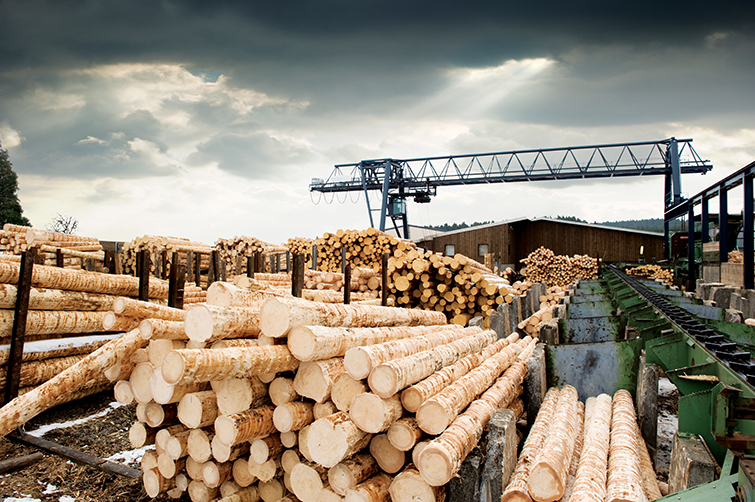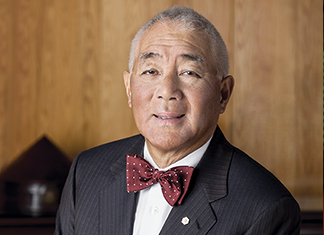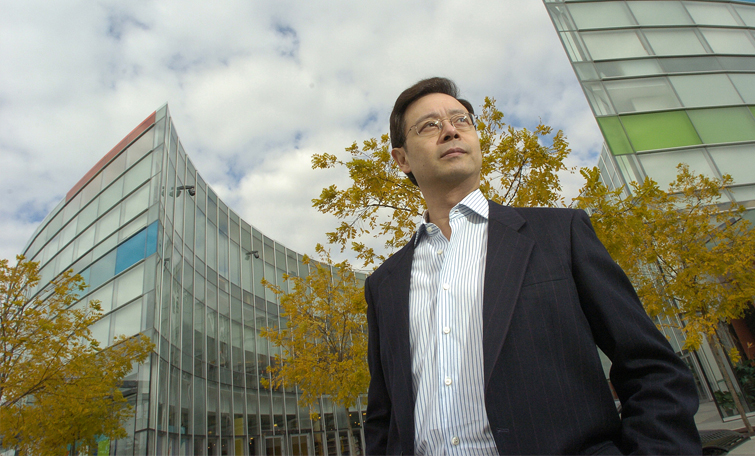The Rise of the Softwood Lumber Industry in China: A Shining Example of International Trade Relations
- Caifu Magazine | by Millie Lou
- EN
British Columbia is North America’s largest softwood lumber producer. Traditionally, B.C.’s forest industry contributes about $12 billion CAD annually to the provincial gross domestic product. The majority of B.C.’s softwood lumber is exported abroad, with the U.S. leading the way as the largest importer, followed by China. According to BC Council for Forest Industries (COFI), the U.S. accounts for 48 percent of B.C.’s export market. China, meanwhile, now accounts for 29 percent, representing a meteoric growth of more than 20 times since 2003.

At the 2017 COFI Convention held in the Vancouver Convention Centre in April 2017, Kirsten Hillman, the Assistant Deputy Minister of Global Affairs Canada, cited the B.C. lumber industry as a “shining example” for other Canadian industries on how to do trade internationally, particularly with China. A combined and sustained effort from the government, lumber associations and industry, as well as good timing, has resulted in a healthy trade relationship with China and a thriving market for B.C.’s softwood lumber.

Kirsten Hillman, the Assistant Deputy Minister of Global Affairs Canada.
Concerted Efforts to Diversify Markets
Before 2006, more than 80 percent of B.C.’s softwood lumber exports were destined for the U.S. The province’s exports of softwood lumber to China accounted for less than 300,000 cubic metres, making up less than 1 percent of all B.C. softwood lumber exports. Meanwhile, in China, Russian lumber occupied about 70 percent of the Chinese lumber market. Chinese people were unfamiliar with Canada’s softwood lumber and how to use it. For example, the Chinese did not use softwood lumber for real estate construction or furniture. In the early 2000s, there was a concerted effort from the Canadian government, associations and industry to build a China market for softwood lumber.

Don Kayne, chief executive officer of Canfor Corporation.
The industry recognizes Don Kayne, chief executive officer of Canfor Corporation, as one of the first to see the potential for a softwood lumber market in China. In an interview in April 2017, Susan Yurkovich, President of COFI, said: “Canfor is one of the first companies focused on pushing into China and [Don] was really instrumental in that process. Canfor has been a leader in that area.” In 2006, Canfor set up an office in Shanghai while its Canadian competitors were still using local Chinese agents. It was a risky investment considering lumber sales were still minimal at the time.
Kayne told CAIFU in April 2017, “We needed to really own a company there as opposed to being an agent.” He wanted to demonstrate to the China market that Canfor was serious about investing in the long term. Almost immediately, Canfor partnered with the Shanghai Institute of Technology to start a construction school that educated students on how to use wood in construction. This was the grassroots of mobilizing an industry to start building with wood.
While lumber companies like Canfor were investing in the market, so was the government. Kayne remembered taking numerous government missions to China starting in the early 2000s. He recalled: “We went every year -- sometimes two or three times a year -- to meet with the Chinese government, [particularly with] the Ministry of Housing and Urban-Rural Development. We developed all the right relationships at the senior level of housing.”
In 2003, the B.C. government launched the organization, Forest Innovation Investment (FII), to work with the province’s lumber companies and the federal government to develop and diversify markets for B.C. forest products. China was the one of the first overseas markets FII focused on. Among the participants of the government missions to China were associations, including BC Council for Forest Industries (COFI).

Susan Yurkovich, President of COFI
Yurkovich of COFI explained the role of associations in building a China market for B.C. lumber products: “Governments work with the ministries in China. [COFI] works collectively under the brand Canada Wood and we build the commercial relationships. Initially, we focused on building a culture of using wood. We support architects, builders and anyone who is planning communities. We help them see the opportunities of wood and we provide them with technical expertise.” She added: “It’s a whole series of programs designed to get people to build with wood.”
Together, industry, the government and associations built a market in China for softwood lumber. Kayne shared: “I have never seen a better example of the federal government, the provincial government, industry as well as the associations, all working together for a common goal. We clearly came together and recognized that individually we would never have accomplished what we accomplished. All three parts played significant roles in advancing the progress in China to where we are today.”
According to the B.C. government trade data, Canada relies on the U.S. market a lot less since 2010. In recent years, China imports between 20 percent to 30 percent of B.C.’s softwood exports. While Canada’s concerted efforts are commendable, timing was also another key factor for the progress in China today.
Serendipity
Prior to 2008, a series of events happened that turned out to be serendipitous for the development of the China market. First, in April 2001 the Softwood Lumber Agreement between the U.S. and Canada ended, resulting in another round of litigation and duties imposed on Canadian lumber. A new agreement was reached five years later.
The lumber dispute between the two countries has been ongoing since 1981, with periods of ceasefire when temporary agreements were reached. Today, Canada is facing another round of American duties on Canadian lumber because the 2006 Softwood Lumber Agreement expired in October 2015. The trade actions Canada confronted back over a decade ago motivated Canadians to invest in diversifying its export markets.
In addition to trade wars with its neighbour, Canada suffered at the hands of Mother Nature. The mountain pine beetles infestation of Canadian pine trees reached its peak in 2005. According to Natural Resources Canada, the total cumulative losses from the [2005] outbreak are projected to be 752 million cubic metres (58 percent) of the merchantable pine volume by 2017. Fortunately, the beetle-damaged wood still had some commercial value; it was a cheaper, low-grade, product suitable for applications like concrete forming. As a result of the mountain pine beetle epidemic, Canada had a high volume of low-grade products to sell.
Finally, the straw that broke the camel’s back was the American 2008 housing crisis, which significantly slowed the U.S. demand for lumber. Suddenly, Canada produced a high volume of low-grade lumber and its best customer was no longer buying. Canada turned to China to sell its low-grade lumber, at a time when concrete construction was booming.

Tony Cao, VP of Canfor (Shanghai) Corporation
In April 2017, Tony Cao, VP of Canfor (Shanghai) Corporation, explained to CAIFU that the cheaper wood helped Canada penetrate the market. He thought that without the pine beetles epidemic and the low U.S. demand, perhaps the China market would not be able to accept the more expensive wood in the short term. However, once customers started using Canadian wood, they gradually learned how to use the product and became accustomed to it.
Zhiqiang Chen, Chairman and President of Hengqiang Group, is one of those customers who quickly grew accustomed to Canadian wood. In an April 2017 interview, Chen described the reasons Chinese importers like himself started buying less Russian wood and more Canadian softwood lumber. He explained Canadian contracts are dependable, while products are consistent and better quality.

Zhiqiang Chen, Chairman and President of Hengqiang Group
NEW PARAGRAPH Even though Russia’s lumber resource is abundant and cheaper, Russian contracts, products and customer service may be inconsistent and unreliable. For example, signed Russian contracts will not always be honoured, particularly if market prices increase after the deal was closed but inventory has yet to be delivered. Also, Russian lumber is not treated with the same care as Canadian products; Russian lumber can be too moist and unevenly cut, creating challenges for manufacturers. Chen concluded: “I prefer to import Canadian lumber now.”
China’s Lumber Market Today
Yurkovich of COFI explained: “We found an initial market [in China] for our low-grade product, and now we have been moving up the value chain.” Kayne of Canfor further emphasized: “The growth in the higher value applications is the most important growth for our industry because that’s what we try to manufacture, not the low-grade [product] that helped get us into the market.”
The Chinese importer Chen said in the last two years, the market has shifted to use higher-grade lumber products for construction, interior design and furniture manufacturing. As the urbanized middle class seeks respite from concrete jungles that permeate big cities, resorts across China are being built to cater to tourism. The Chinese government wants these resorts to be “natural, beautiful villas” that are environmentally friendly.
Kayne commented: “In the past 12 months, the Chinese government, from Xi [Jinping] and Li [Keqiang] both, as well as Chen [Zhenggao] who is the Minister of Housing and Urban-Rural Development, has endorsed wood frame construction and solid wood as a green building product of choice.” As of June 2017, the Chinese government will officially issue a formal building code for using wood.
As the government encourages green initiatives and the growing middle class has the disposable income to pursue a better quality of life, the demand for solid wood furniture also rises. “China just began upgrading its use of lumber,” Cao said. “Furniture manufacturers are gradually making products from Canadian softwood lumber rather than particle board, high-density fibreboard or medium density fibreboard. There is a lot of potential in the furniture market.”
From a supplier’s point of view, Kayne said he recognized another trend: “In China, we see a huge shift from [interacting with] state-owned enterprises to private enterprises, which has been great. These companies are manufacturers and they need reliable supply. High value products are harder to come by so they have really tried to partner with us over the past several years. We are just seeing it being recognized now.”
Part of the partnership was customizing products for the China market. Cao explained that about two years ago, Canfor took the initiative to consult clients on product needs. Based on client feedback, the Canadian lumber company recently launched new products with customized dimensions designed for the China market. Chen added: “These customized products made sales very easy in China.”
The Outlook on the Lumber Trade between Canada and China
Canfor’s CEO said he believes the industry is on the cusp of significant growth in the next five to 10 years, especially for those companies that have invested heavily in its assets, and have spent the time to develop the China market. Kayne said: “[These companies] will have some terrific opportunities in the future.” Chen said he agrees. As a top 10 importer of Canadian lumber in China, he said he thinks the Chinese lumber industry will continue to expand its use of Canadian lumber.
On the political side, the outlook is also positive. Hillman, one of the lead negotiators for Canada’s international trade deals, revealed: “As a federal government, we recently launched an exploratory discussion with China. This discussion is to determine whether or not we can achieve a free trade agreement.” Hillman added she already had a few meetings with her Chinese counterpart. Simultaneously, the government is consulting Canadian businesses on the matter.















